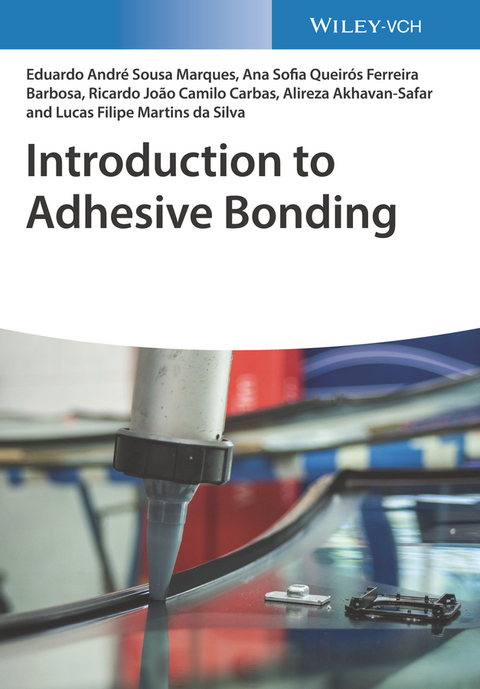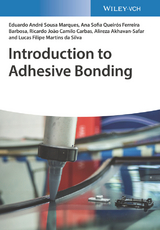Introduction to Adhesive Bonding
Wiley-VCH (Verlag)
978-3-527-34869-5 (ISBN)
Adhesive bonding - the process of joining two surfaces using glues, epoxies, plastic agents, and other adhesives - is a major technique with wide applications in industries as a diverse as aerospace, footwear manufacturing, and food packaging. Adhesive bonding holds several advantages over conventional joining techniques, such as uniform stress concentrations, protection of the bonded surfaces or joints, and the ability to join a variety of different materials and irregular surfaces.
Introduction to Adhesive Bonding provides an accessible overview of the principles and common applications of adhesive bonding. Using a systematic approach, the authors thoroughly explain each step necessary to achieve a successful adhesive bond, including surface preparation, bonding agent selection, design and construction of bonded joints, health and safety considerations, and quality control. Readers are provided with both the theoretical foundation and practical information required to plan and complete their own adhesive bonding projects. This comprehensive yet reader-friendly volume:
* Highlights the inherent advantages of adhesive bonding in various applications
* Describes the use of adhesive bonding in the development of novel and advanced projects in different industries
* Features numerous real-world examples of adhesive bonding in areas such as the transportation industry, civil engineering, medical applications, and sports equipment
* Discusses how adhesives enable development of new products and constructions of reduced weight and size
* Identifies important limitations and durability concerns of the use of adhesives in specific applications
Introduction to Adhesive Bonding is an ideal textbook for undergraduate or graduate Engineering and Chemistry programs, and a useful reference for researchers and industry professionals working in fields such as Engineering, Surface and Polymer Chemistry, and Materials Science.
Lucas F M da Silva is Full Professor at the Department of Mechanical Engineering of the Faculty of Engineering of the University of Porto and Director of the Integrated Master in Mechanical Engineering. He obtained his PhD in bonding of composites from the University of Bristol (UK) in 2004. He has published 327 ISI papers and 24 books (9 as author and 15 as editor) mainly on adhesive joint mechanics. His papers were cited 8263 times and correspond to an h-index of 50 (SCOPUS, 01/2020). He leads the Adhesives Group, composed of post-docs, PhD students and MSs students. The work covers adhesives mechanical characterization, especially in terms of fracture toughness, adhesive joint modelling with analytical models and finite element analysisRicardo Carbas is an Assistant Professor at the Department of Mechanical Engineering of the Faculty of Engineering of the University of Porto, He obtained his PhD in adhesive bond technologies in 2013 from the University of Porto (Portugal). He has published 55 ISI papers on adhesive technologies. His papers were cited 881 times and correspond to an h-index of 16 (SCOPUS, 01/2020).Eduardo Marques is an Assistant Researcher in Institute of Science and Innovation in Mechanical and Industrial, he obtained his PhD in adhesive bond technologies in 2016 from the University of Porto (Portugal). He has published 55 ISI papers on adhesive technologies. His papers were cited 666 times and correspond to an h-index of 15 (SCOPUS, 01/2020).Ana Queirós Barbosa are currently is an Assistant Researcher in Institute of Science and Innovation in Mechanical and Industrial, she obtained her PhD in Reinforcement adhesives in 2017 and MSc in Material Science from the University of Porto (Portugal). She has published 18 ISI papers and book chapter mainly on adhesive technologies. Her papers were cited 157 times and correspond to an h-index of 7 (SCOPUS, 01/2020).Alireza Ahkavan-Safar are currently is an Assistant Researcher in Institute of Science and Innovation in Mechanical and Industrial, he obtained his PhD in Adhesive mechanical characterization in 2017 from the Iran University of Science and Technology (Iran). He has published 17 ISI paper mainly on adhesive characterization. His papers were cited 60 times and correspond to an h-index of 4 (SCOPUS, 01/2020).
Chapter 1 - BENEFITS, LIMITATIONS AND APPLICATIONS OF ADHESIVE BONDING
1.1 - Definition of basic concepts
1.2 - Historical context on adhesive bonding
1.3 - Benefits and limitations of adhesive bonding
1.4 - Examples of current applications of adhesive bonding
1.4.1 - Transportation
1.4.1.1 - Aeronautical industry
1.4.1.2 - Road transport and rail industry
1.4.1.3 - Naval industry
1.4.2 - Civil engineering
1.4.2.1 - Tiling
1.4.2.2 - Floor covering
1.4.2.3 - Anchoring systems
1.4.2.4 - Building facades
1.4.2.5 - Wooden construction
1.4.3 - Labelling and packaging industry
1.4.3.1 - Labelling of consumable products
1.4.3.2 - Packaging
1.4.4 - Medical applications and devices
1.4.5 - Electronic devices
1.4.6 - Sport equipment
1.4.7 - Footwear
Chapter 2 - PRINCIPLES OF ADHESION
2.1 - Forces associated with adhesion
2.2 - Surface roughness
2.3 - Wettability
2.4 - Adhesion and cohesion work
2.5 - Spreading
2.6 - Adhesion theories
2.6.1 - Adsorption theory
2.6.2 - Mechanical theory
2.6.3 - Diffusion theory
2.6.4 - Electrostatic theory
2.7 - Defects and weak spots in adhesive joints
Chapter 3 - SURFACE PREPARATION
3.1 - Objectives of surface preparation
3.2 - Classes of substrate materials
3.2.1 - Metals
3.2.2 - Polymers
3.2.3 - Composites
3.2.4 - Other materials
3.3 - Surface preparation processes
3.3.1 - Passive processes
3.3.2 - Active processes
3.3.3 - Primers and adhesion promoters
3.4 - Conservation of the post-treatment surface
Chapter 4 - MAIN FAMILIES OF ADHESIVES AND ADHESIVE SELECTION
4.1 - Typical composition of a modern adhesive
4.2- Methods for adhesive classification
4.2.1 - Molecular structure
4.2.2 - Physical form
4.2.3 - Mechanical properties
4.2.4 - Hardening and implementation method
4.2.5 - Chemical composition
4.3 - Main structural adhesives
4.3.1 - Epoxy adhesives
4.3.2 - Polyurethane adhesives
4.3.3 - Acrylic adhesives
4.3.4 - Phenolic adhesives
4.3.5 - Aromatic adhesives
4.4 - Main non-structural adhesives
4.4.1 - Elastomeric adhesives
4.4.2 - Polyester adhesives
4.4.3 - Hotmelt adhesives
4.4.4 - Inorganic adhesives
4.5 - How to select an adhesive
4.5.1 - Case study: adhesive selection for the automotive industry
4.6 - How to test and characterize an adhesive
4.6.1 - Mechanical testing
4.7 - Mechanical properties of adhesives
Chapter 5 - MANUFACTURE
5.1 - Adhesive storage
5.1.1 - Storage time
5.1.2 - Humidity
5.1.3 - Temperature
5.1.4 - Light and UV radiation
5.2 - Adhesive metering and mixing
5.2.1 - Adhesive metering
5.2.2 - Adhesive mixing
5.3 - Adhesive forms and application
5.3.1 - Liquid adhesives
5.3.2 - Paste adhesives
5.3.3 - Film adhesives
5.3.4 -Tapes
5.4 - Joint assembly and fixturing
5.4.1 - Moulds and fixtures
5.4.2 - Adhesive thickness control
5.4.3 - Joint assembly
5.5 - Adhesive hardening
5.5.1 - Heat curing processes
5.5.2 - Evaporation based processes
5.6 - Finishing steps
Chapter 6 - QUALITY CONTROL
6.1 - Quality control of the incoming materials
6.1.1 - Control of adhesive quality
6.1.2 - Control of adherend quality
6.2 - Quality control of the manufacturing process
6.3 - Quality control on bonded structures
6.3.1 - Types of defects present in bonded joints
6.3.2 - Destructive tests
6.3.3 - Non-destructive tests
Chapter 7 - ENVIRONMENT, HEALTH AND SAFETY
7.1 - Toxicity of adhesives: are adhesives really toxic?
7.2 - General precautions for handling adhesives
7.2.1 - Pictograms
7.2.2 - Training for handling adhesives
7.3 - Hazardous characteristics of the most common adhesives
7.3.1 -Structural adhesives
7.3.2 - Non-structural adhesives
7.4 - Surface preparation precautions
7.5 - Adhesive application precautions
7.6 - Environmental protection
7.6.1 - Air
7.6.2 - Water
7.6.3 - Soil
Chapter 8 - DESIGN OF BONDED JOINTS
8.1 - Main loading modes on adhesive joints
8.2 - Main adhesive joint geometries
8.3 - Joint strength prediction using analytical methods
8.3.1 - Determination of stresses acting on an adhesive joint
8.3.2 - Failure criteria for bonded joints
8.4 - Joint strength prediction using numerical methods
8.5 - Parameters which affect joint performance
8.5.1 - Effect of adhesive thickness
8.5.2 - Effect of overlap length
8.5.3 - Effect of temperature and thermal stresses
8.6 - Methods to improve joint strength
8.6.1 - Adhesive fillet
8.6.2 - Mixed adhesive joints
8.6.3 - Functionally graded joints
8.6.4 - Hybrid joints
8.7 - Case studies
Case study 1 - Effect of adhesive type on joint strength
Case study 2 - Effect of overlap length and adherend type
Case study 3 - Effect of adhesive thickness
Case study 4 - Strength prediction of adhesive joints with composite adherends
Case study 5 - Strength prediction of a SLJ with cohesive zone modelling
Case study 6 - Effect of thermal stresses on adhesive joints
Chapter 9 - DURABILITY OF ADHESIVELY BONDED JOINTS
9.1 - Environmental effects
9.1.1 - Hygrothermal ageing
9.1.2 - Temperature
9.2 - Loading conditions
9.2.1 - Fatigue
9.2.2 - Creep
Chapter 10 - CASE STUDIES
10.1 - Vehicle construction
10.2 - Seat fixation in passenger trains
10.3 - Aeronautical applications
10.4 - Flexible cooling circuits
10.5 - Glass to metal bonding in appliances
10.6 - Roof coverings
10.7 - Shoe manufacture
10.8 - Food packaging
| Erscheinungsdatum | 14.07.2021 |
|---|---|
| Verlagsort | Weinheim |
| Sprache | englisch |
| Maße | 170 x 244 mm |
| Gewicht | 518 g |
| Themenwelt | Naturwissenschaften ► Chemie ► Technische Chemie |
| Technik ► Maschinenbau | |
| Schlagworte | Adhäsion • chemical engineering • Chemische Verfahrenstechnik • Joining, Welding and Adhesion • Kleben • Materials Science • Materialwissenschaften • Metalle u. Legierungen / Verbinden, Schweißen u. Kleben • Polymer Science & Technology • Polymerwissenschaft • Polymerwissenschaft u. -technologie |
| ISBN-10 | 3-527-34869-7 / 3527348697 |
| ISBN-13 | 978-3-527-34869-5 / 9783527348695 |
| Zustand | Neuware |
| Haben Sie eine Frage zum Produkt? |
aus dem Bereich




